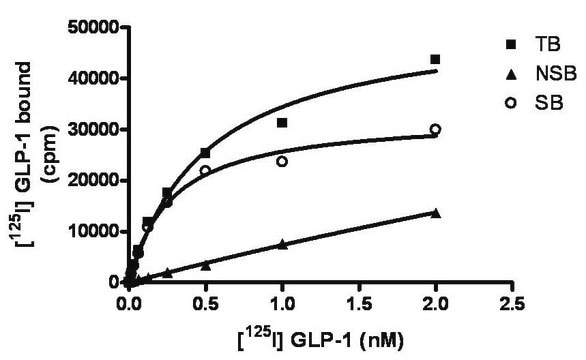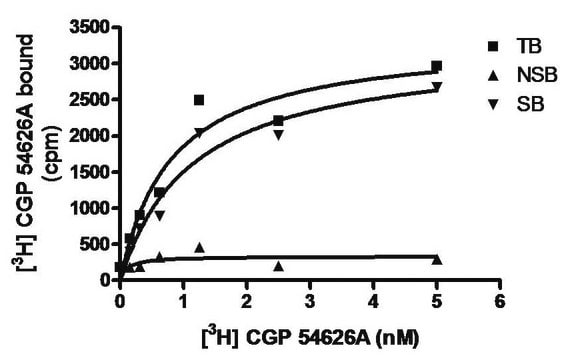HTS027M
ChemiSCREEN GnRH Membrane Preparation
Human GnRH / LHRH GPCR membrane preparation for Radioligand binding Assays & GTPgammaS binding.
Anmeldenzur Ansicht organisationsspezifischer und vertraglich vereinbarter Preise
Alle Fotos(1)
About This Item
UNSPSC-Code:
41106514
eCl@ss:
32161000
NACRES:
NA.84
Empfohlene Produkte
Biologische Quelle
human
Qualitätsniveau
Rekombinant
expressed in Chem-1 cells
Hersteller/Markenname
ChemiScreen
Chemicon®
Konzentration
0.5 mg/mL
Methode(n)
ligand binding assay: suitable (GTPγS)
radioligand binding assay (RLBA): suitable
NCBI-Hinterlegungsnummer
UniProt-Hinterlegungsnummer
Versandbedingung
dry ice
Allgemeine Beschreibung
Gonadotropin-releasing hormone (GnRH), also known as luteinizing hormone-releasing hormone (LHRH), regulates the reproductive hormonal cascade in vertebrates. Upon release from the hypothalamus, GnRH stimulates secretion of luteinizing hormone and follicle-stimulating hormone from the pituitary. In humans, the type I GnRH receptor is a GPCR that is unusual in the lack of a cytoplasmic C-terminal tail. Although some species contain a type II GnRH receptor, the human version of this second receptor appears to contain mutations that render it inactive. GnRH analogs (agonists) are used in low doses in a pulsatile fashion in the treatment of infertility, delayed puberty and cryptorchidism. GnRH agonists at high doses desensitize the receptor, and are used along with antagonists in the treatment of hormone-dependent diseases (Millar et al., 2004). Chemicon′s cloned human type I GnRH receptor-expressing cell line is made in the Chem-1 host, which supports high levels of recombinant GnRH receptor expression on the cell surface and contains high levels of the promiscuous G protein Galpha15 to couple the receptor to the calcium signaling pathway. Thus, the cell line is an ideal tool for screening for agonists and antagonists of the GnRH receptor.
Human Type I GnRH receptor
Anwendung
Radioligand binding assay, and GTPgammaS binding.
Biochem./physiol. Wirkung
GPCR Class: A
Protein Target: GnRH / LHRH
Target Sub-Family: GnRH
Qualität
SPECIFICATIONS: Bmax: 1.0 pmol/mg
Kd: 0.3 nM
Kd: 0.3 nM
Spezifikationen
Inucbation Conditions
Membranes are mixed with radioactive ligand and unlabeled competitor (see Figures 1 and 2 for concentrations tested) in binding buffer in a nonbinding 96-well plate, and incubated for 1-2 h. Prior to filtration, a GF/C 96-well filter plate is coated with 0.33% polyethyleneimine for 30 min, then washed with 50 mM HEPES, pH 7.4, 0.5% BSA. Binding reaction is transferred to the filter plate, and washed 3 times (1 mL per well per wash) with Wash Buffer. The plate is dried and counted.
Binding buffer: 50 mM Hepes, pH 7.4, 5 mM MgCl2, 1 mM CaCl2, 0.2% BSA, filtered and stored at 4°C
Radioligand: [125I]-[D-Trp6]-LHRH (Perkin Elmer # NEX365)
Wash Buffer: 50 mM Hepes, pH 7.4, 500 mM NaCl , 0.1% BSA, filtered and stored at 4°C.
One vial contains enough membranes for at least 200 assays (units), where an unit is the amount of membrane that will yield greater than 3-fold signal:background with 125I-labeled [D-Trp6]-LHRH at 0.5nM.
Membranes are mixed with radioactive ligand and unlabeled competitor (see Figures 1 and 2 for concentrations tested) in binding buffer in a nonbinding 96-well plate, and incubated for 1-2 h. Prior to filtration, a GF/C 96-well filter plate is coated with 0.33% polyethyleneimine for 30 min, then washed with 50 mM HEPES, pH 7.4, 0.5% BSA. Binding reaction is transferred to the filter plate, and washed 3 times (1 mL per well per wash) with Wash Buffer. The plate is dried and counted.
Binding buffer: 50 mM Hepes, pH 7.4, 5 mM MgCl2, 1 mM CaCl2, 0.2% BSA, filtered and stored at 4°C
Radioligand: [125I]-[D-Trp6]-LHRH (Perkin Elmer # NEX365)
Wash Buffer: 50 mM Hepes, pH 7.4, 500 mM NaCl , 0.1% BSA, filtered and stored at 4°C.
One vial contains enough membranes for at least 200 assays (units), where an unit is the amount of membrane that will yield greater than 3-fold signal:background with 125I-labeled [D-Trp6]-LHRH at 0.5nM.
Physikalische Form
Liquid in packaging buffer: 50 mM Tris pH 7.4, 10% glycerol and 1% BSA no preservatives.Packaging method: Membranes protein were adjusted to 2.0 mg/ml in 1 mL packaging buffer, rapidly frozen, and stored at -80oC.
Lagerung und Haltbarkeit
Maintain frozen at -70°C for up to 2 years. Do not freeze and thaw.
Rechtliche Hinweise
CHEMICON is a registered trademark of Merck KGaA, Darmstadt, Germany
Haftungsausschluss
Unless otherwise stated in our catalog or other company documentation accompanying the product(s), our products are intended for research use only and are not to be used for any other purpose, which includes but is not limited to, unauthorized commercial uses, in vitro diagnostic uses, ex vivo or in vivo therapeutic uses or any type of consumption or application to humans or animals.
Lagerklassenschlüssel
12 - Non Combustible Liquids
WGK
WGK 2
Flammpunkt (°F)
Not applicable
Flammpunkt (°C)
Not applicable
Analysenzertifikate (COA)
Suchen Sie nach Analysenzertifikate (COA), indem Sie die Lot-/Chargennummer des Produkts eingeben. Lot- und Chargennummern sind auf dem Produktetikett hinter den Wörtern ‘Lot’ oder ‘Batch’ (Lot oder Charge) zu finden.
Besitzen Sie dieses Produkt bereits?
In der Dokumentenbibliothek finden Sie die Dokumentation zu den Produkten, die Sie kürzlich erworben haben.
Gonadotropin-releasing hormone receptors.
Millar, Robert P, et al.
Endocrine Reviews, 25, 235-275 (2004)
Unser Team von Wissenschaftlern verfügt über Erfahrung in allen Forschungsbereichen einschließlich Life Science, Materialwissenschaften, chemischer Synthese, Chromatographie, Analytik und vielen mehr..
Setzen Sie sich mit dem technischen Dienst in Verbindung.




